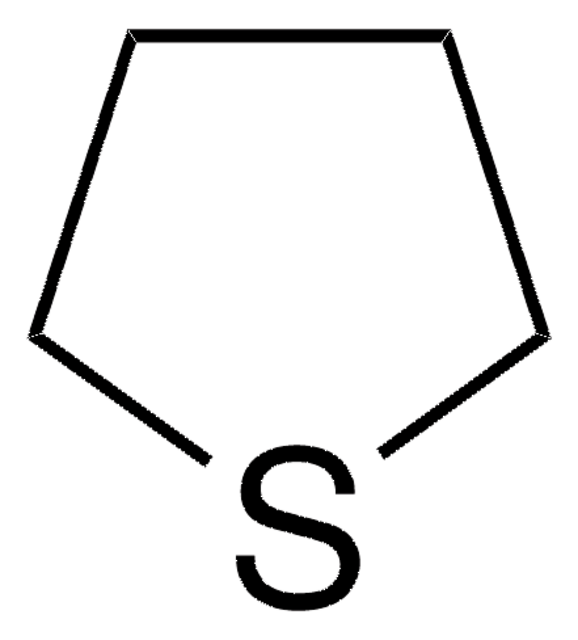8.20833
Dimethyl sulfide
for synthesis
Sinónimos:
Dimethyl sulfide, Methyl sulfide
About This Item
Productos recomendados
presión de vapor
530 hPa ( 25 °C)
Nivel de calidad
Análisis
≥99.0% (GC)
formulario
liquid
temp. de autoignición
205 °C
potencia
535 mg/kg LD50, oral (Rat)
>5000 mg/kg LD50, skin (Rabbit)
lim. expl.
2.2-19.7 % (v/v)
bp
37 °C/1013 hPa
mp
-98 °C
temperatura de transición
flash point <-30 °C
solubilidad
7.28 g/L
densidad
0.85 g/cm3 at 20 °C
temp. de almacenamiento
2-8°C
InChI
1S/C2H6S/c1-3-2/h1-2H3
Clave InChI
QMMFVYPAHWMCMS-UHFFFAOYSA-N
Aplicación
- Application of Synthetic Flavors in Zebrafish Rearing: The study details the effects of using synthetic flavors, including dimethyl sulfide, in the aquaculture of zebrafish, highlighting benefits in fish development and welfare. This application suggests potential for broader aquaculture practices (Conti et al., 2023).
- Impact of Sulfur Fertilizers on Potato Tuber Flavor: Research explored the combined application of phosphorus and sulfur fertilizers on the flavor of potato tubers, noting that sulfur compounds like dimethyl sulfide can influence agricultural product quality (Li et al., 2023).
- Two-Dimensional Platelets Assembly: A study demonstrated the use of small molecules including dimethyl sulfide for the living self-assembly of metastable and stable two-dimensional platelets, offering insights into novel materials engineering methods (Liao et al., 2023).
- Enhancement of Volatile Flavor Compounds: Investigation on the effect of instant pressure drop treatment on the volatile flavor compounds in whole highland barley flour. The study emphasizes the role of dimethyl sulfide in enhancing food flavors through advanced processing techniques (Chen et al., 2023).
- Role in Marine Biogeochemical Cycles: This research highlighted the contribution of fungi to the increased production of dimethylsulfoniopropionate (DMSP), a precursor to dimethyl sulfide, in kelp ecosystems, underscoring its importance in marine biogeochemical cycles (Perkins et al., 2023).
Nota de análisis
Density (d 20 °C/ 4 °C): 0.847 - 0.849
Identity (IR): passes test
Palabra de señalización
Danger
Frases de peligro
Consejos de prudencia
Clasificaciones de peligro
Flam. Liq. 2
Código de clase de almacenamiento
3 - Flammable liquids
Clase de riesgo para el agua (WGK)
WGK 1
Punto de inflamabilidad (°F)
-32.8 °F - closed cup
Punto de inflamabilidad (°C)
-36 °C - closed cup
Certificados de análisis (COA)
Busque Certificados de análisis (COA) introduciendo el número de lote del producto. Los números de lote se encuentran en la etiqueta del producto después de las palabras «Lot» o «Batch»
¿Ya tiene este producto?
Encuentre la documentación para los productos que ha comprado recientemente en la Biblioteca de documentos.
Nuestro equipo de científicos tiene experiencia en todas las áreas de investigación: Ciencias de la vida, Ciencia de los materiales, Síntesis química, Cromatografía, Analítica y muchas otras.
Póngase en contacto con el Servicio técnico





